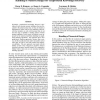183 search results - page 24 / 37 » Analyzing graph structure via linear measurements |
CORR
2008
Springer
13 years 7 months ago
2008
Springer
Abstract. We propose a number of techniques for learning a global ranking from data that may be incomplete and imbalanced -- characteristics that are almost universal to modern dat...
MP
2011
13 years 2 months ago
2011
We propose a number of techniques for obtaining a global ranking from data that may be incomplete and imbalanced — characteristics that are almost universal to modern datasets co...
VCBM
2010
13 years 2 months ago
2010
We present the latest developments in modeling 3D biomedical data via the Medial Scaffold (MS), a 3D acyclic oriented graph representation of the Medial Axis (MA) [LK07, SP08]. Th...
BMCBI
2006
13 years 7 months ago
2006
Background: Modeling of gene expression data from time course experiments often involves the use of linear models such as those obtained from principal component analysis (PCA), i...
FLAIRS
2010
13 years 10 months ago
2010
Nowadays, graph-based knowledge discovery algorithms do not consider numeric attributes (they are discarded in the preprocessing step, or they are treated as alphanumeric values w...



